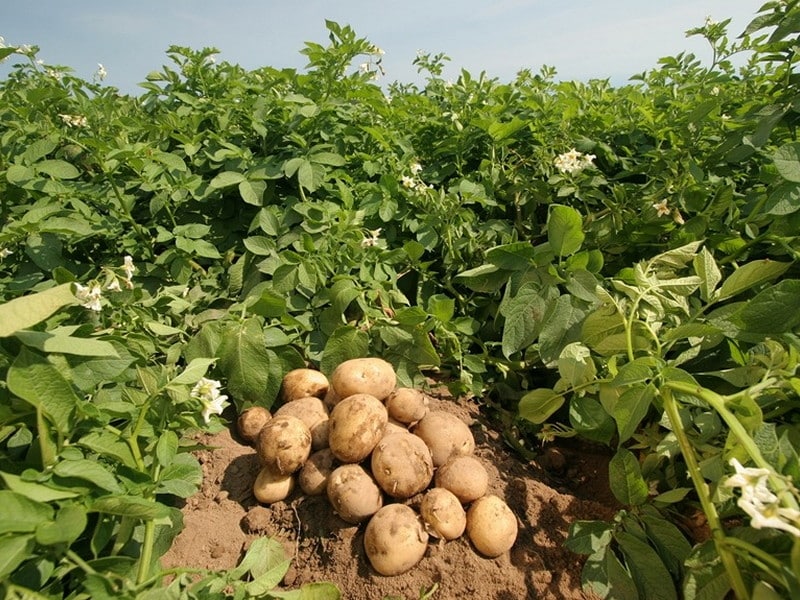Potatoes, sometimes known as “ground apples,” are a highly popular and adaptable crop enjoyed worldwide. These starchy wonders have become permanent in creamy mashed potatoes or crispy french fries. In this article, we’ll explore the fascinating world of potato farming, learn about planting methods, tackle diseases, and the art of harvesting.
Cultivation Process of Potatoes Farming
1. Selecting the Right Seed
Choosing the right seed potatoes is crucial. Look for certified disease-free varieties suited for your region and intended use. Smaller seed potatoes with at least one or two eyes are ideal for planting.
2. Preparing the Soil
Potatoes can thrive in most types of soil that drain well, but they don’t like it when the soil gets too wet. Since they grow underground, they prefer loose and crumbly soil to heavy and packed clay soil. This way, their roots can get the air and water they require to grow comfortably.
2. Land Preparation
First, prepare the bed for planting by digging the soil around 20-25 cm deep and then smoothing it. Before you plant the seeds, make sure the soil is naturally damp. You can use a Mahindra JIVO 305 DI tractor to help with this process.
3. Planting
Planting can be done through cuttings or whole-seed potatoes. Cut larger seed potatoes into smaller pieces, ensuring each has at least one eye. Plant them at a depth of around 4 inches.
4. Spacing and Rows
Space potato plants about 12 to 15 inches apart in rows around 2 to 3 feet apart. Proper spacing allows for healthy growth and ample air circulation, reducing disease risks.
5. Hilling and Mounding
As the plants grow, hill soil around the base of the plants. This encourages tuber development and prevents the greening of the tubers due to exposure to sunlight.
Managing Potato Plants
1. Watering
Potatoes require consistent moisture, especially during the tuber formation stage. However, avoid overwatering, which can lead to diseases like late blight.
2. Fertilization
Balanced fertilisation is essential for optimal potato growth. Apply a fertiliser rich in phosphorus and potassium to promote tuber development.
3. Disease Prevention
Potatoes are susceptible to various diseases, including late blight and early blight. Practice crop rotation, choose disease-resistant varieties, and consider applying organic fungicides to manage conditions.
4. Weed Control
Keep the potato beds weed-free to prevent competition for nutrients and reduce the risk of disease spread.
Harvesting and Storage
1. Harvest Timing
Potatoes can be harvested when the plants begin to flower or when the foliage starts to die. Gently dig around the plants to avoid damaging the tubers.
2. Curing
After harvesting, let the potatoes cure for a week in a cool, dark, and well-ventilated place. This helps to toughen the skin and extends its storage life.
3. Storage
Store cured potatoes in a dark, cool, humid environment, ideally around 40°F (4°C). Proper storage conditions prevent sprouting and decay.
Benefits of Potato Farming
1. Dietary Staple
Potatoes provide a substantial source of carbohydrates, making them a vital part of diets worldwide.
2. Nutritional Value
They are rich in vitamin C, B6, and potassium, essential for maintaining good health.
3. Versatile Cooking Ingredients
Potatoes can be prepared in numerous ways, offering culinary diversity and taste.
4. Profitable Crop
Potatoes have a high yield potential and strong market demand, making them economically rewarding for farmers.
Challenges and Innovations
While potato farming has shown remarkable growth, it has been challenging. One significant challenge is the susceptibility of potatoes to various diseases, such as late blight and bacterial wilt. These diseases can cause significant yield losses if not managed effectively. To deal with this, farmers use smart ways to handle pests, like combining different methods, changing the crops they grow, and planting crops that can resist diseases.
Another problem is the unpredictable weather changes caused by climate change. Erratic rainfall and temperature fluctuations can impact potato yields, making farmers need to adopt climate-smart agricultural practices and explore drought-resistant varieties.
Economic Impact
Potato farming has a substantial economic impact on India. It provides livelihoods to millions of farmers, labourers, and traders involved in various stages of the potato value chain. The crop also contributes to the food processing industry, with potatoes used to make chips, fries, snacks, and other processed products. The commercial success of these products further fuels the demand for potato cultivation.
Government Initiatives
The Indian government knows that growing potatoes is important, so they started different plans to help farmers. They’re giving out good seeds, showing farmers how to use science for farming, and giving money for new ideas in potato farming. These plans want to make more potatoes, waste less after harvesting, and improve potato farmers’ lives.
Export Potential
India needs to grow more potatoes for itself; it could also become a big part of the world’s potato market. The country’s diverse agro-climatic zones allow for year-round production, making it possible to supply potatoes when other major producing countries face off-seasons. However, to fully tap into the export potential, India must focus on improving storage facilities, quality control, and meeting international standards.
Conclusion
Potato farming presents both opportunities and challenges for growers. By following proper planting techniques and employing effective harvesting practices, farmers can reap the benefits of this valuable crop, naturally using equipment like the Mahindra JIVO 365 DI. Whether grown on a small scale for personal use or on a larger scale for commercial purposes, potatoes remain a reliable and important part of global agriculture and cuisine.





